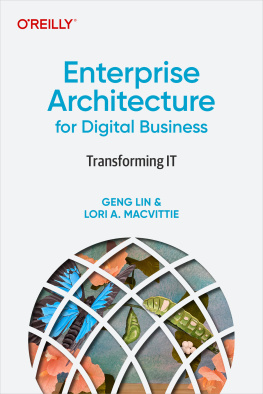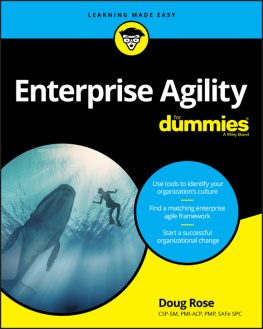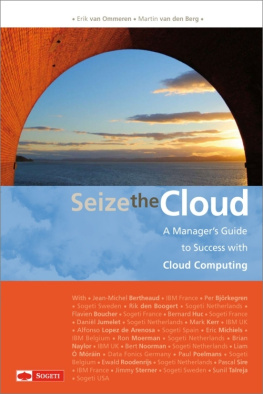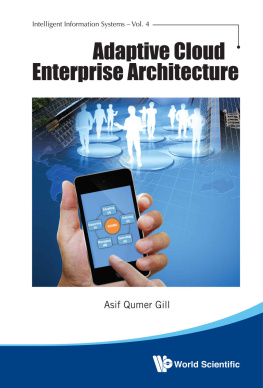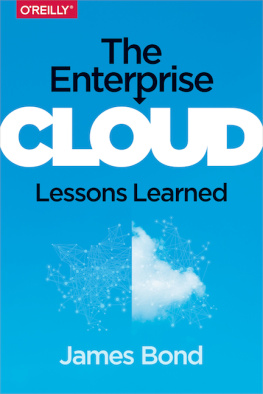Wiley Cio Series
Founded in 1807, John Wiley & Sons is the oldest independent publishing company in the United States. With offices in North America, Europe, Asia, and Australia, Wiley is globally committed to developing and marketing print and electronic products and services for our customers' professional and personal knowledge and understanding.
The Wiley CIO series provides information, tools, and insights to IT executives and managers. The products in this series cover a wide range of topics that supply strategic and implementation guidance on the latest technology trends, leadership, and emerging best practices.
Titles in the Wiley CIO series include:
The Agile Architecture Revolution: How Cloud Computing, REST-Based SOA, and Mobile Computing Are Changing Enterprise IT by Jason Bloomberg
Big Data, Big Analytics: Emerging Business Intelligence and Analytic Trends for Today's Businesses by Michele Chambers, Ambiga Dhiraj, and Michael Minelli
The Chief Information Officer's Body of Knowledge: People, Process, and Technology by Dean Lane
CIO Best Practices: Enabling Strategic Value with Information Technology by Joe Stenzel, Randy Betancourt, Gary Cokins, Alyssa Farrell, Bill Flemming, Michael H. Hugos, Jonathan Hujsak, and Karl D. Schubert
The CIO Playbook: Strategies and Best Practices for IT Leaders to Deliver Value by Nicholas R. Colisto
Enterprise IT Strategy, + Website: An Executive Guide for Generating Optimal ROI from Critical IT Investments by Gregory J. Fell
Executive's Guide to Virtual Worlds: How Avatars Are Transforming Your Business and Your Brand by Lonnie Benson
Innovating for Growth and Value: How CIOs Lead Continuous Transformation in the Modern Enterprise by Hunter Muller
IT Leadership Manual: Roadmap to Becoming a Trusted Business Partner by Alan R. Guibord
Managing Electronic Records: Methods, Best Practices, and Technologies by Robert F. Smallwood
On Top of the Cloud: How CIOs Leverage New Technologies to Drive Change and Build Value Across the Enterprise by Hunter Muller
Straight to the Top: CIO Leadership in a Mobile, Social, and Cloud-based (Second Edition) by Gregory S. Smith
Strategic IT: Best Practices for IT Managers and Executives by Arthur M. Langer
Strategic IT Management: Transforming Business in Turbulent Times by Robert J. Benson
Transforming IT Culture: How to Use Social Intelligence, Human Factors and Collaboration to Create an IT Department That Outperforms by Frank Wander
Unleashing the Power of IT: Bringing People, Business, and Technology Together by Dan Roberts
The U.S. Technology Skills Gap: What Every Technology Executive Must Know to Save America's Future by Gary Beach

Cover image: 4X-image/iStockphoto
Cover design: John Wiley & Sons, Inc.
Copyright 2013 by Jason Bloomberg. All rights reserved.
Published by John Wiley & Sons, Inc., Hoboken, New Jersey.
Published simultaneously in Canada.
No part of this publication may be reproduced, stored in a retrieval system, or transmitted in any form or by any means, electronic, mechanical, photocopying, recording, scanning, or otherwise, except as permitted under Section 107 or 108 of the 1976 United States Copyright Act, without either the prior written permission of the Publisher, or authorization through payment of the appropriate per-copy fee to the Copyright Clearance Center, Inc., 222 Rosewood Drive, Danvers, MA 01923, (978) 750-8400, fax (978) 646-8600, or on the Web at www.copyright.com . Requests to the Publisher for permission should be addressed to the Permissions Department, John Wiley & Sons, Inc., 111 River Street, Hoboken, NJ 07030, (201) 748-6011, fax (201) 748-6008, or online at http://www.wiley.com/go/permissions .
Limit of Liability/Disclaimer of Warranty: While the publisher and author have used their best efforts in preparing this book, they make no representations or warranties with respect to the accuracy or completeness of the contents of this book and specifically disclaim any implied warranties of merchantability or fitness for a particular purpose. No warranty may be created or extended by sales representatives or written sales materials. The advice and strategies contained herein may not be suitable for your situation. You should consult with a professional where appropriate. Neither the publisher nor author shall be liable for any loss of profit or any other commercial damages, including but not limited to special, incidental, consequential, or other damages.
For general information on our other products and services or for technical support, please contact our Customer Care Department within the United States at (800) 762-2974, outside the United States at (317) 572-3993 or fax (317) 572-4002.
Wiley publishes in a variety of print and electronic formats and by print-on-demand. Some material included with standard print versions of this book may not be included in e-books or in print-on-demand. If this book refers to media such as a CD or DVD that is not included in the version you purchased, you may download this material at http://booksupport.wiley.com . For more information about Wiley products, visit www.wiley.com .
Library of Congress Cataloging-in-Publication Data:
Bloomberg, Jason, 1961
The agile architecture revolution : how cloud computing, REST-based SOA, and mobile computing are changing enterprise IT / Jason Bloomberg ; with contributions from Ronald Schmelzer.
pages cm
Includes index.
ISBN 978-1-118-40977-0 (hbk.); ISBN 978-1-118-42199-4 (ebk); ISBN 978-1-118-55405-0 (ebk); ISBN 978-1-118-41787-4 (ebk); 1. Business enterprisesTechnological innovations. 2. Management information systems. 3. Service-oriented architecture (Computer science) I. Title.
HD45.B5466 2013
658.4038dc23
2012038783
To Ronald Schmelzerbusiness partner, mentor, colleague, parallel entrepreneur, curmudgeon, and friend.
Foreword: The Agile Architecture Revolution
The core thrust of architecture has been to define core business requirements, and then construct the IT solution to meet those requirements, typically as instances of software. While this seems like a simple concept, many in enterprise IT went way off course in the last 10 to 15 years.
IT does not provide the value it once did, meaning IT does not meet the objectives and expectations of the business. Indeed, IT has become a cost center where the resource burn increased significantly over the last 20 years, while the value to the business decreased relative to costs. This can't continue.
We've tried all of the tricks. With waterfall types of approaches to application architecture, the time it takes to move from understanding the requirements to the final deployed system could be years. Thus, by the time the system is completed and deployed, the business requirements likely have changed, you're back to the drawing board, and the delivered system has significantly diminished in value.
To address the latency issues around the waterfall, those who design and build systems turned to the concept of interaction. This means moving through cycles of understand-design-develop-deploy, over and over again, until there is something that resembles the desired business solution. Iteration approaches to software development often lead to poorly designed and lower-quality systems because you get it wrong over and over again, seemingly to get it right once. Moreover, as requirements change, it's back to the iterations again, sometimes in a never-ending loop.
Next page


